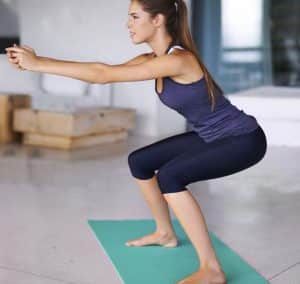The science of middle-age slimness, and how to avoid piling on weight


People who practised yoga reduced their waist circumference by about 1cm in a year, a study found.
• By PETA BEE
• THE TIMES
•
You know you’ve reached middle age when weight loss becomes an uphill struggle. There are a multitude of factors stacked against us, not least a slowing metabolism and the shifts in hormones that typically contribute to wider hips in women and a paunch in men. Our activity levels typically begin a slow decline, and we naturally lose muscle mass so that the average middle-aged body is increasingly composed of fat.
Midlife weight gain occurs even if our lifestyle remains unchanged. A study from the Karolinska Institutet in Sweden published in the journal Nature Medicine last month, found that our lipid turnover — the rate at which we store and remove fat from our fat cells — slows with age.
For its trial, the Swedish team followed one group of 54 men and women for an average of 13 years, and another group of 41 women who had been “morbidly obese” before undergoing gastric band surgery, who were tracked for five years. In all of the participants fat turnover slowed as they got to middle age and older — although not all gained weight.
Among those who did more exercise and consumed fewer calories over the intervening years in a bid to offset middle-age spread, some maintained their weight, but participants who made no lifestyle changes and whose food intake, dietary composition and physical activities remained the same (or worsened) were found to have gained 20 per cent of their body weight over the duration of the study. “The results indicate for the first time that processes in our fat tissue regulate changes in body weight during ageing in a way that is independent of other factors,” says Peter Arner, a professor at the department of medicine at Karolinska Institutet and one of the study’s lead authors.
What it means, suggest the researchers, is that weight gain in middle age is more or less inevitable unless we act to prevent it.
So what steps should we be taking?
Aim for 300 fewer calories
Fact: you need fewer calories at 40 than you did at 30. The World Health Organisation estimates that our basal metabolic rate, which indicates the energy our bodies need to function normally, decreases by an average 2.9 per cent in men and 2 per cent in women over each decade. “Ageing also affects the efficiency with which we digest and metabolise food,” Dr Sarah Schenker, a nutritionist, says. “And the creeping shifts in body composition with a greater proportion of fat to lean muscle mass all mean we need fewer calories to stay in energy balance.”
If you can cut 300 calories a day (about the amount in a muffin or latte), all the better. For a study published in the Lancet Diabetes & Endocrinology journal in September, a team from Duke University, in North Carolina, asked a group of 143 adults, many of whom were middle-aged, to eat whatever they liked but to reduce the total amount of calories they consumed daily by 25 per cent for two years. It was a tall order and not many managed to stick to the recommended reduction. However, on average the dieters manage to eat about 12 per cent fewer total calories — equivalent to cutting 300 calories a day — and, as a result, lost weight and total body fat as well as experiencing health improvements such as lower cholesterol and blood pressure.
Don’t neglect cardio
“Some cardio activity is needed for all-round fitness and a healthy heart and lungs,” says Matt Roberts, a personal trainer and author of Younger, Fitter, Stronger. “But I believe that the ratio needs to change when you hit your forties and that very long-duration cardio should be replaced by shorter distances such as 5km running or some cycling combined with appropriate resistance training.”
If you’re not a runner, try brisk walking. In 2015 researchers at the London School of Economics found that over-50s who did “regular, brisk walking” for more than half an hour a day had smaller waist measurements and lower body mass indexes than others who went to the gym or played sports such as rugby.
Lift weights
As we lose muscle with age, it tends to be replaced with fat tissue, which is less metabolically active and burns fewer calories. “Weight training will help to offset the metabolic and physical changes that come with advancing age,” Roberts says. “It is important for preserving muscle mass and the more we have, the greater our body’s fat-burning ability.”
This has been shown time and again, including by researchers at Wake Forest School of Medicine in North Carolina who looked at the outcome of different exercise approaches on the weight loss of men and women in their sixties. Results of the 18-month long study, published in the journal Obesity, showed that people who had cut calories but not exercised lost an average of 5.44kg each, those who dieted and walked briskly on a track for 45 minutes, four times a week lost about 9kg each, the same amount as those who had cut calories and weight-trained, performing a full-body regimen in the gym four times weekly. Where resistance training won was in the type of weight loss — walkers lost an impress1ive 7kg of fat, but also lost 1.8kg of important muscle; those on the weight training program shed 8kg of fat and 900g of muscle.
Do 60 seconds of squats daily
“Any weight around the middle is due to our bodies releasing too much insulin and by the time we hit middle age we are becoming more and more insulin-resistant,” says Zana Morris, founder of The Clock gyms in London. “High-intensity exercise of any kind helps in the release of natural growth hormone which, in turn, seems to counteract insulin and target belly fat.”
Among the best approaches is to perform squats as fast and hard as possible for 60 seconds every day. “Place your feet shoulder-width apart and keep your heels pressed into the floor, arms stretched out and your chest up as you drop the hips as close to the floor as you can comfortably go,” Morris says. “Then push back up to standing, engaging the abs and glutes throughout the movement.”
If you prefer to use weights, do this 4-5 times a week. Hold a dumbbell in each hand and drop until your thighs are parallel to the floor. “Do 15 to 20 repetitions at the heaviest weight you can comfortably lift, keeping good form throughout the set,” she says. “Do three sets of this, but reduce the weight lifted for each set so that you finish well.”


Squats are a good way of hitting belly fat.
Eat relatively more protein
While it’s important to eat fewer calories as you get older, where those calories come from also matters. Dropping weight through eating less can lead to muscle and bone loss, which can raise the risk of conditions such as osteoporosis. But making sure that you consume relatively more protein in combination with resistance exercise is key to ensuring that your body stays strong and slim.
Last year researchers from McMaster University in Canada reviewed results from past studies involving 1863 people and showed that men and women who consumed a protein-rich diet while weight training developed larger, stronger muscles than those who did not. This was especially true for middle-aged and older weight trainers. It doesn’t mean buying protein shakes and bars. “It’s about increasing the proportion of protein in your meals,” Schenker says. “So, start adding more chicken and fish, yoghurt, soya nuts and pulses to your diet.”
Stay flexible
Although yoga is not good for fat-blasting — the average 50-minute class burns off 144 calories, no more than a gentle stroll — maintaining flexibility will help to alleviate stiffness after exercise, will keep posture in check and enable you to move freely with less risk of injury. This might translate into weight loss. A 2015 study (Diabetology & Metabolic Syndrome journal) showed that older people who practised yoga reduced their waist circumference by about 1cm in a year.
Exercise before breakfast
Whether or not to work out on an empty stomach has been the subject of scientific debate for decades. For the middle-aged, however, it now seems worthwhile. Results of a six-week study by health scientists at the Universities of Bath and Birmingham, which is to be published shortly in the Journal of Clinical Endocrinology & Metabolism, found that people who performed exercise before breakfast burnt double the amount of fat than the group who exercised after breakfast. According to Javier Gonzalez of the department for health at the University of Bath, the increased fat use is mainly due to lower insulin levels when people have fasted overnight, “which means that they can use more of the fat from their fat tissue and the fat within their muscles as a fuel”.
In terms of overall weight loss, it doesn’t matter when you exercise, but a pre-breakfast workout means you are “better able to respond to insulin, keeping blood sugar levels under control and potentially lowering the risk of diabetes and heart disease”.
Keep tabs on your food intake
Nobody likes to be faced with the stark reality of the weighing scales, but monitoring your weight loss is the best strategy for keeping off the pounds. This year researchers reported in the journal Obesity that the best predictor of middle-age weight loss is recording your calorie and fat intake throughout the day. Or, as they put it, to “write it when you bite it’‘. After six months the most successful dieters in their study were those who logged their food intake online, a task that took them an average 14.6 minutes a day.
“People hate it; they think it’s onerous and awful, but the question we had was: how much time does dietary self-monitoring really take?” said Jean Harvey, the lead author of the study. “The answer is, not very much.” Weighing yourself daily has also been shown to keep middle-age spread at bay.
Try climbing and jogging
Some of us are genetically predisposed to putting on weight but a new study that looked at the biobank data of 18,424 people aged between 30 and 70 suggests that you can outwit your fat genes provided you select the right sort of activity.
A Taiwanese team of researchers divided subjects into four groups according to their genetic vulnerability to gain weight based on 50 obesity-related gene variants. Six activities were identified as most effective in offsetting the influence of fat genes. Top of the list was running for the subjects saddled with unlucky DNA. Those who jogged regularly were the least likely to be overweight and had the best ratio of fat-to-lean tissue mass in spite of their inherited susceptibility to obesity. Climbing, long-duration yoga sessions, ballroom dancing, power walking and even slower walking to clock up several miles at a time were also found to be beneficial.
The Times
Get A Gym Membership Today.
Call now, we’d love to welcome you to our Southport Gym.
